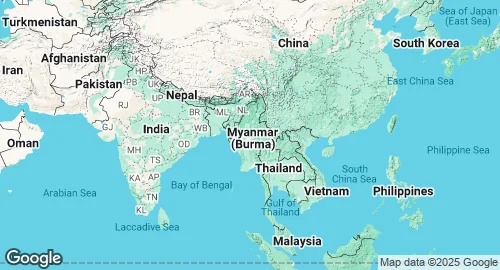Myanmar Military Forces 🇲🇲
Military Strength Overview
| 🛩️ Air Force | 317 active aircraft |
| ⚓️ Naval forces |
240 ships in fleet
– incl. 3 submarines |
| 🪖 Active Troops | 201,000 personnels |
| 👮♀️ Paramilitary | 107,000 personnels |
Defense Statistics & Key Metrics
| Population | 54.1 million (2023) |
| GDP | $66.8 billion (2023) |
| GDP per capita | $1233 (2023) |
| Military Budget | $5.0 billion (2024) |
| Share of GDP in Milex | 6.8% (2024) |
| Share of Govt Expenditures | 29.1% (2024) |
| Military spends per capita | $92 (2024) |
| Inflation Rate | 8.83% (2019) |
| Military Personnel | 463,000 (2020) |
Strategic Overview in 2025
Myanmar's armed forces, the Tatmadaw, are currently facing the most significant existential threat in their history. Once an unassailable institution that has dominated the country's political and economic landscape for decades, the military is now embroiled in a multifront civil war against a determined and evolving opposition. The February 2021 coup d'état, which overthrew the democratically elected government, has plunged the nation into a deep crisis, stretching the Tatmadaw's resources and manpower to their limits. The military's strategic calculus is no longer focused on external threats but on internal control and survival.
Force Structure and Manpower Crisis
The Tatmadaw is composed of the Army, Navy, and Air Force, with the Army being the largest and most dominant branch. Prior to the coup, estimates placed the total military personnel between 300,000 and 400,000. However, a combination of heavy combat losses, desertions, and defections since 2021 has drastically reduced its effective strength. Current credible estimates suggest the total number of personnel is between 150,000 and 200,000, with approximately 70,000 serving as combat soldiers. This manpower shortage is a critical vulnerability, which the junta has attempted to address by activating a national conscription law in early 2024 and recalling veterans. The Tatmadaw is now struggling to maintain control over vast swathes of the country, having ceded territory to a coalition of ethnic armed organizations (EAOs) and the People's Defense Forces (PDF), the armed wing of the shadow National Unity Government.
Equipment and Defense Industry
The Tatmadaw's arsenal is a mix of older, indigenously produced hardware and more modern imported systems. The Directorate of Defence Industries (DI) is a state-owned enterprise responsible for manufacturing a range of military equipment, from small arms to artillery and armored vehicles. Myanmar's defense industry can produce assault rifles, mortars, anti-tank weapons, and landmines, making the army largely self-sufficient in basic weaponry.
However, for more advanced capabilities, Myanmar relies heavily on foreign suppliers. Russia has been a key partner, providing Yak-130 jet trainers and agreeing to the sale of Su-30 multi-role fighter jets. China is another significant supplier, providing a variety of military hardware, including transport aircraft and potentially SY-400 ballistic missile systems. India has also supplied military equipment, including advanced light torpedoes for the navy and has donated jet trainers. These foreign-supplied assets, particularly combat aircraft and drones, have been instrumental in the Tatmadaw's efforts to counter the resistance, allowing it to project power and conduct airstrikes across the country.
Strategic Trends and Outlook
The primary strategic trend for the Tatmadaw is its ongoing war of attrition against a determined and increasingly capable domestic insurgency. The military has adopted a "five cuts" strategy, aiming to deprive the resistance of food, finances, intelligence, recruits, and communications. This has involved brutal tactics against civilian populations and has led to a protracted stalemate, with neither side able to achieve a decisive victory.
Geopolitically, the Tatmadaw is largely isolated, facing sanctions from Western nations. Its reliance on Russia and China for advanced weaponry and diplomatic support has deepened. Neighboring countries are increasingly concerned about the instability on their borders, with the conflict disrupting regional projects and creating refugee flows. The long-term outlook for the Tatmadaw is precarious. While it remains a real fighting force with a significant advantage in heavy weaponry and airpower, its manpower crisis and the widespread public opposition present a grave challenge to its long-term viability and control over the nation.
Myanmar/ Burma Military Budget History
Population and Military Personnel Trends
GDP and Inflation Rate Trends
Military Expenditure: SIPRI Milex.
